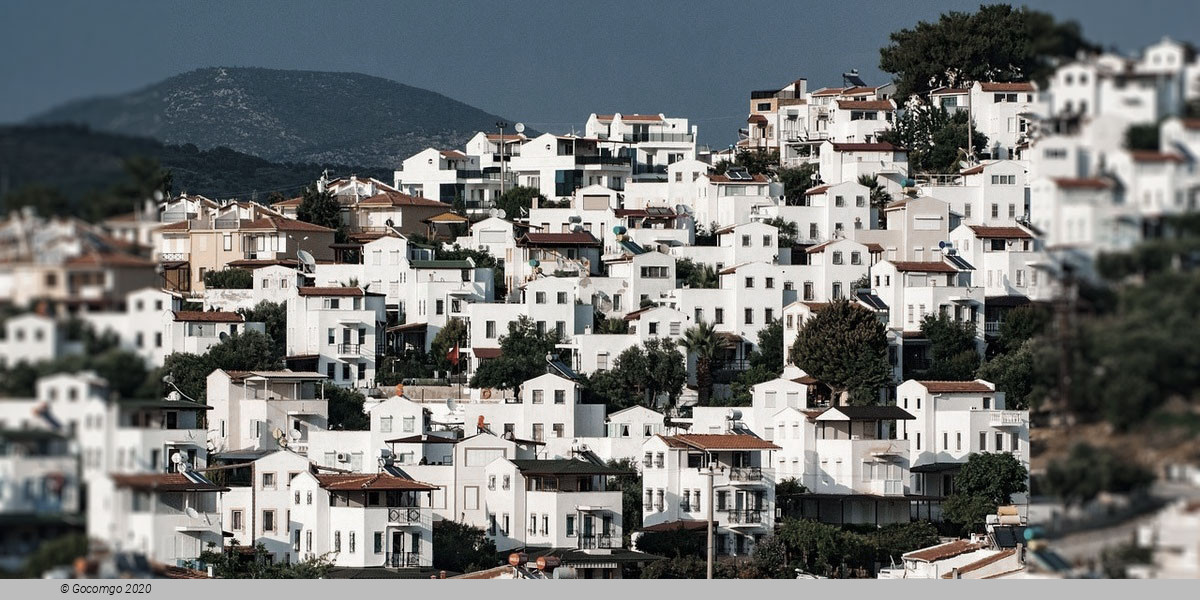Kuşadası

Kuşadası is a large resort town on Turkey's Aegean coast, and the center of the seaside district of the same name within Aydın Province. Kuşadası is 95 km (59 mi) south of İzmir, and about 60 km (37 mi) from Aydın. The municipality's primary industry is tourism.
History
Etymology
The name Kuşadası comes from the Turkish words kuş (bird) and ada (island), as the island has the shape of a bird's head (when seen from the sea). It was known as Ephesus Neopolis (Greek: Ἔφεσος Νεόπολις) during the Byzantine era, and later as Scala Nova or Scala Nuova under the Genoese and Venetians. Kuş Adası was adopted in its place at the beginning of the 20th century. Today, the citizens of Kuşadası often shorten the town's name to Ada.
Antiquity
The area has been a centre of art and culture since some of the earliest recorded history, and has been settled by many civilizations since being founded by the Leleges people in 3000 BC. Later settlers include the Aeolians in the 11th century BC and Ionians in the 9th. Originally, seamen and traders built a number of settlements along the coastline, including Neopolis.
An outpost of Ephesus in ancient Ionia, known as Pygela (Πύγελα) was located in the area between the Büyük Menderes (Maeander) and Gediz (Hermos) rivers. The original Neopolis, is thought to have been founded on the nearby point of Yılancı Burnu. Later settlements were probably built on the hillside of Pilavtepe, in the district called Andızkulesi today. Kuşadası was a minor port frequented by vessels trading along the Aegean coast. In antiquity it was overshadowed by Ephesus, until Ephesus' harbor silted up. From the 7th century BC onwards the coast was ruled by Lydians from their capital at Sardis, then from 546 BC the Persians, and from 334 BC, along with all of Anatolia, the coast was conquered by Alexander the Great. From that point on the coastal cities in Anatolia became a centre of Hellenistic culture.
Rome and Christianity
The Roman Empire took possession of the coast in the 2nd century BC and made it their provincial capital in the early years of Christianity. Saint John the Evangelist and (according to Roman Catholic sacred tradition) the Virgin Mary both came to live in the area, which in the Christian era became known as "Ania".
As Byzantine, Venetian and Genoese shippers began to trade along the coast, the port was re-founded (by the name of Scala Nova or Scala Nuova, meaning "New Port"), a garrison was placed on the island, and the town centre shifted from the hillside to the coast.
The Turkish era
Long afterwards, in 1834, the castle and garrison on the island were rebuilt and expanded, becoming the focus of the town. This was to such an extent that people began to refer to the whole town as Kuşadası (bird island). However, in the 19th century, trade began to decline in favor of other nearby cities with the opening of the İzmir-Selçuk-Aydın railway, which bypassed Kuşadası.
During the Turkish War of Independence, Kuşadası was occupied from 1919-1922, first by Italian troops between 14 May 1919 and 24 May 1922, and then by Greek troops. The Turkish forces eventually gained control of the city on September 7, 1922.
Under the Republic of Turkey, the Greek population was exchanged for Turkish people as part of the population exchange between Greece and Turkey in 1922. It was a district in İzmir Province until its transfer to Aydın Province in 27 June 1957.

